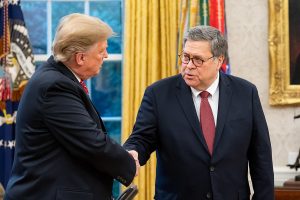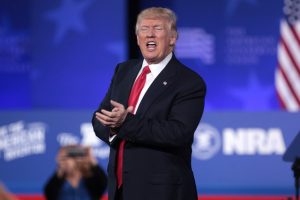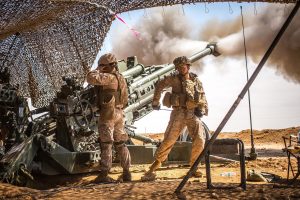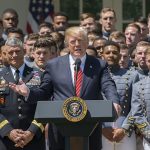by John Feffer
My first trip to Washington, DC to do something other than protest on the streets was to interview for a Herbert Scoville Jr. Peace Fellowship, which brings young people to the nation’s capital to work on arms control and disarmament.
It was 1987, around the time that Ronald Reagan and Mikhail Gorbachev signed the Intermediate-Range Nuclear Forces (INF) Agreement. The INF treaty committed the United States and the Soviet Union to eliminate nuclear weapons for the first time on a large scale (over 2,500 of them by 1991). It was a high point for the arms control movement.
To get to the interview stage, however, I wrote an application essay about the flaws of arms control agreements — that they provided a false sense of accomplishment, that they capped the number of nuclear weapons but rarely reduced them, that they accepted the “logic” of mutually assured destruction, that they reinforced the privileges of the nuclear club, and so on.
Arms control was conventionally thought of as the path toward disarmament. I made the case instead that arms control was a detour around disarmament.
When I walked into the room for my interview, I found myself facing a dozen of the leading arms control advocates in the country. I’d anticipated a one-on-one discussion, not a full court of inquisition. They understandably grilled me about my arguments and looked universally dissatisfied with my answers. Yet, in the end, they gave me a fellowship, perhaps for the same reason that Antonin Scalia liked to employ one liberal Supreme Court clerk — to have a dissenter close at hand to sharpen arguments. I did my fellowship at Nuclear Times magazine, a periodical devoted to scrapping nuclear weapons rather than merely controlling their production.
Nuclear Times folded long ago. Now the INF agreement, after both the United States and Russia suspended their compliance this February, is effectively dead too. Led by National Security Advisor John Bolton, an inveterate opponent of arms control, the Trump administration has taken aim at a wide range of efforts to control the production and proliferation of weapons, from the Iran nuclear deal to the Arms Trade Treaty that the president just savaged in front of a group of cheering National Rifle Association members.
And yet, Trump has also said, just this week, that he wants to get rid of all nuclear weapons. So, is it time to write an epitaph for arms control and herald a new age of disarmament?
The Swerve
Since my time at Nuclear Times, two major events contributed to pushing some otherwise conservative policy makers away from arms control and towards actual disarmament.
The first development was the collapse of the Soviet Union. The number of nuclear weapons in the world peaked the year before my Washington interview at just over 70,000. The end of the Cold War spurred a reduction to under 14,000 today.
Also, in 1991, Democrat Sam Nunn and Republican Richard Lugar teamed up to create a groundbreaking piece of legislation, the Cooperative Threat Reduction (CTR) Program, later dubbed the Nunn-Lugar Act. It provided U.S. funds to decommission weapons of mass destruction in the former Soviet states. Among other results of the program, the new states of Ukraine, Kazakhstan, and Belarus became the first countries in history to abandon their nuclear weapons.
But attempts to negotiate a new set of arms control treaties with Russia have run up against a number of obstacles, from the intransigence of congressional hawks to Russia’s seizure of Crimea and involvement in the civil war in Ukraine. Over the years, Congress has chipped away at the funding for CTR. And Richard Lugar died this weekend, the passing of one of the last moderate Republicans committed to a cooperative U.S. relationship with the world.
The other half of Nunn-Lugar, meanwhile, has been part of the second major development: the response to global terrorism.
In 2007, Sam Nunn joined Henry Kissinger, George Shultz, and William Perry to author a series of op-eds in The Wall Street Journal urging the foreign policy establishment to embrace not just arms control, but disarmament. They expressed concern about states like North Korea and Iran acquiring nuclear weapons and disrupting the tenuous balance of nuclear power. But they reserved most of their anxiety for scenarios in which non-state actors acquired nukes:
In today’s war waged on world order by terrorists, nuclear weapons are the ultimate means of mass devastation. And non-state terrorist groups with nuclear weapons are conceptually outside the bounds of a deterrent strategy and present difficult new security challenges.
The United States built an arsenal of nuclear weapons to preserve and extend its global dominance. But now, in a perverse development, nukes threatened that dominance. So, the lions of U.S. foreign policy had decided that they must go. No longer convinced that nukes kept the peace, they pushed for a world free of these weapons of mass destruction.
Two years later, clearly influenced by these arguments, President Barack Obama gave a speech in Prague announcing for the first time that the United States was committed to nuclear disarmament. He outlined a number of steps toward that goal: a new Strategic Arms Reduction Treaty with Moscow, U.S. ratification of the Comprehensive Test Ban Treaty, a fissile material cut-off treaty, a strengthened Nuclear Non-Proliferation Treaty, and so on. It was an impressive to-do list, but alas this agenda remains unrealized.
The nuclear stand-off of the Cold War was predicated on predictability. The United States and Soviet Union wouldn’t launch a first strike because of the near certainty that the other side would then engage in massive retaliation. But the end of the Cold War and the possibility that nuclear material would fall into the hands of unpredictable actors changed the nuclear calculus.
Then, to complicate matters further, along came the most unpredictable element of all: Donald Trump.
The Trump Paradox
As the self-professed king of negotiators, Donald Trump used to boast of his ability to solve the nuclear impasse if only the U.S. government would appoint him as special emissary to the Soviet Union. Within an hour of meeting Gorbachev, Trump told Nobel Peace Prize winner Bernard Lown, he could end the Cold War. In an article for The New York Times in 1984, journalist William Geist wrote:
The idea that he would ever be allowed to get into a room alone and negotiate for the United States, let alone be successful in disarming the world, seems the naive musing of an optimistic, deluded young man who has never lost at anything he has tried. But he believes that through years of making his views known and through supporting candidates who share his views, it could someday happen.
Young no more and now in a powerful political position, Trump still holds on to this illusion. But to achieve his ambition of personally disarming the world, Trump believes that first he has to get rid of all the poorly negotiated efforts of his predecessors. In this endeavor he is aided by Bolton, who has made it his personal mission to torpedo every arms control treaty that he can bring within his sights.
That’s why the Trump administration seems to be all over the map on arms control. On the one hand, the president has withdrawn from the nuclear deal with Iran and pulled out of one of the last remaining arms control agreements with Russia, the aforementioned INF treaty.
Then, last week, he announced that he would unsign the Arms Trade Treaty, which the Obama administration supported and which imposes a number of important restrictions on the sale and transfer of armaments across borders. The Senate has yet to ratify the treaty. Over 100 nations have both signed and ratified the ATT, and it went into effect in 2014. Trump, by denigrating the ATT, has thrown the United States into the same camp of opposition as North Korea, Iran, China, and Russia.
On the other hand, Trump also declared last week:
Between Russia and China and us, we’re all making hundreds of billions of dollars’ worth of weapons, including nuclear, which is ridiculous. And I would say that China will come along, and I would say Russia will come along. It doesn’t really make sense that we’re doing this.
The president has thus instructed officials to prepare for big agreements on nuclear weapons with both Russia and China.
To get from here (dangerous) to there (disarmament), Trump has to follow some pretty obvious steps, points out David Wright, of the Union of Concerned Scientists. These include a new treaty on strategic nuclear weapons with Russia, reentry into the INF Treaty, scaling back on missile defense, and kicking Bolton out of his administration. So far, Trump has expressed zero interest in making any of these moves.
When it comes to any kind of large-scale arms control treaty with Russia and/or China, as Daryl Kimball writes in Arms Control Today, the administration has “no plan, strategy, or capacity to negotiate such a far-reaching deal. Even if it did, negotiations would likely take years.” Kimball suspects that the administration has an entirely different goal in mind: to load the arms-control agenda with so many big asks that it makes future deals, like a new strategic treaty with Russia, untenable. Kimball continues:
If in the coming weeks, however, Team Trump suggests China must join New START or that Russia must agree to limits on tactical nuclear weapons as a condition for its extension, that should be recognized as a disingenuous poison pill designed to create a pretext for killing New START.
Trump will soon come to the same realization on arms control that he did on health care: “Nobody knew [it] could be so complicated.”
Of course, everyone knew that health care — and arms control — could be so complicated. Only Trump believes that he alone, though force of will, can substitute for the patient and informed diplomacy of hundreds of experts. As with his efforts to negotiate with North Korea, once he bumps up against the complexity of the situation, Trump will hand over responsibility for the details to his aides — and that means that Bolton will have a free hand to block any progress in talks with Russia and China.
Since 1987, the logic of arms control has changed. Because of the end of the Cold War, arms control agreements have led to dramatic reductions in nuclear forces and the prevention of states like Iran from becoming nuclear powers. The threat of nuclear material falling into the hands of non-state actors, meanwhile, has shifted the consensus away from deterrence and toward disarmament. Arms control is now clearly part of the solution, not part of the problem.
So, I’ve changed my mind about arms control being a detour around disarmament. Arms control has become more important than ever before, given that a new nuclear arms race beckons.
The United States, China, Russia are all modernizing their arsenals. Key arms control treaties, like the INF, no longer serve as checks on weapon development and deployment. Important initiatives like the Comprehensive Test Ban treaty can’t go forward without U.S. support. The nuclear club refuses to sign the new treaty on the prohibition of nuclear weapons. And John Bolton is on the loose, like a fox bent on killing off every inhabitant of the henhouse.
So, it isn’t just Donald Trump who has a paradoxical attitude toward nuclear weapons. The world as a whole has never been closer to consensus on the need for disarmament. And yet it’s also never been further away, in a practical sense, from following the necessary steps to achieving global zero.
Perhaps, however, this is only a temporary paradox. Let’s hope that the Trump administration proves to be the detour on the path to finally bidding farewell to nuclear arms.






Nice job by John Feffer – interesting to read the history of his involvement with nuclear arms control. However, the humanitarian disaster waiting to happen, which led to adoption of the Ban Treaty in 2017, does not come across strongly enough.
A recent local speaker, in a talk on China-US relations, effectively made the case against nuclear weapons by saying China would never launch a nuclear attack on the US because Chinese leadership knows that some fifty US 0.5-1 Megaton nukes could wipe out most of the densely populated Chinese territory, and send multi-hundreds of million people out of this world. Doing that would take less than 5% of the US strategic nuclear weapons ready to go if the president were to push his “bigger” button.
Rhetorical questions: Does US leadership understand that similar mega-destruction could happen to the US? Does the American public? Is there a public humanitarian duty to make the case for disarmament of nuclear weapons? John Feffer is one who is trying. Keep it up!